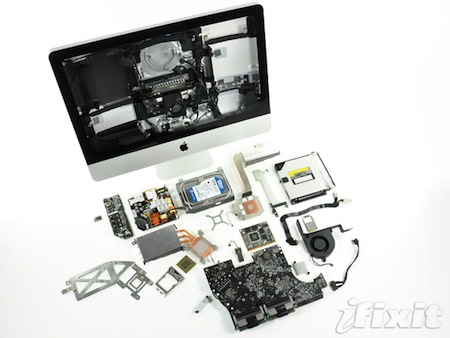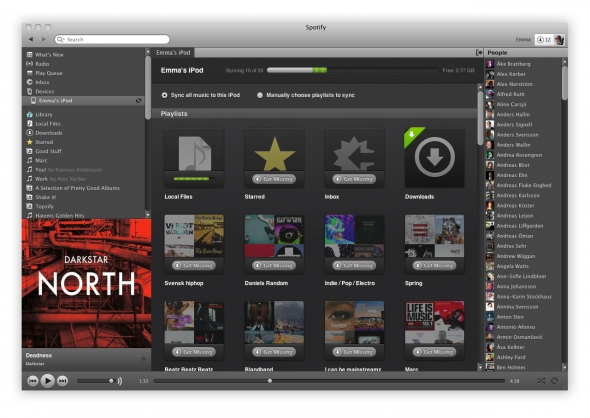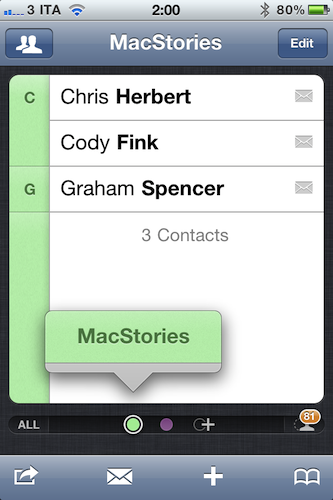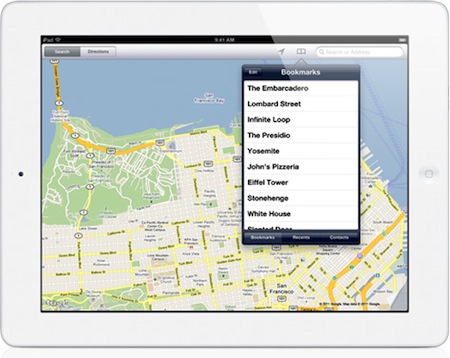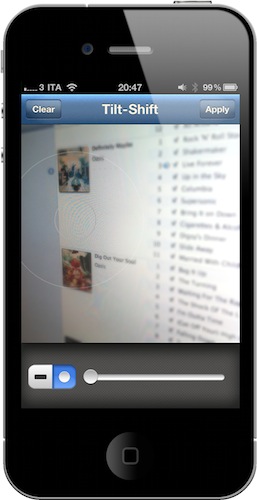Following yesterday’s release of the new iMacs with Sandy Bridge processors and Thunderbolt technology, the guys over at iFixit immediately started tearing down a 21.5-inch model. In their official teardown article, available here, there are a few notes of interest: iFixit notes how, design-wise, nothing much has changed in the new iMacs, which can be opened in the same way of the old generation units by pulling off the magnetically-held glass and removing the screws holding the LCD in place. The display is manufactured by LG and it’s the same used in the previous-generation iMac. iFixit also gives the machine a 7/10 Repairability Score, noting that average users can easily replace RAM, but accessing the CPU and GPU requires to take out the whole logic board, which is described as a “tricky process.” The teardown also reveals the Thunderbolt connector is similar (but not the same) to the one found in the early-2011 MacBook Pros; one heat sink is reserved for the CPU, with the other assigned to the GPU. Read more
New iMacs: Teardown, First Benchmarks
Spotify Now Lets You Sync MP3s To Your iPod Without iTunes
Spotify, the music streaming service that counts millions of active users in Europe but has been struggling to launch in the US due to the lack of deals with major music labels, announced some important new features last night, both for Premium and Free users. With an update to the official desktop app that will automatically roll out to all users in the next few days to “ensure technical quality”, Spotify now allows you to sync your music to an iPod Classic, iPod Shuffle or iPod Nano without using iTunes at all. With the new Spotify, users will be able to place the MP3s they bought (more on this in a minute) or saved locally inside a playlist (as they usually do) and sync these playlists to an iPod thanks to the new “Devices” section in the app’s sidebar. It’s worth noting that Spotify doesn’t allow sync via USB cable to iOS devices, as they’re only focusing on standard iPod models now. However, with the updated mobile app for iPhone and iPod touch (now also available to free users for playlist sync, whilst Premium subscribers retain the ability to stream everything) users get the possibility to sync playlists wirelessly. Clearly, Spotify has set out to become the standard music player for many both on the desktop and mobile devices, although the software still can’t sync back to iOS devices like iPhones and iPads through a USB cable. Plus, the lack of a native iPad app still makes it impossible for iPad users to properly enjoy the Spotify experience.
For the first time, seamlessly manage any iPod classic, iPod nano and iPod shuffle in Spotify. Simply connect your iPod to your computer via your USB cable and watch it magically appear in the new ‘Devices’ section of your Spotify sidebar.
iPod integration was your biggest request, but there are also a lot of Spotify Free users out there who are iPhone and Android phone owners. You asked for the ability to buy your MP3 playlists and sync to your phones. So we’ve got you covered too…
As of today, everyone can download the Spotify Mobile iPhone & Android apps to wirelessly sync your MP3 playlists in Spotify from your computer to your phone. Fire up your mobile app and see your phone appear in the ‘Devices’ section of the Spotify sidebar, ready to rock and roll. No cables required!
As mentioned above, users can now take the music they bought or already own on the go all the time. Spotify is, in fact, launching a new “download service” that, through a simple click&buy interface, allows you to purchase a range of MP3 bundles offered by the service starting at 50p per song. I haven’t managed to test the new music store and iPod Classic integration as the update is still rolling out and I don’t have it available, but from what Spotify unveiled last night, it really looks like the company’s intention is to take on Apple and (the future) iTunes with a mix of streaming, local cache, USB sync, and online store. The variety of apps offered by Spotify surely gives them an important head start in the music streaming scene for mobile devices, but they obviously still can’t compete with the music catalogue offered by iTunes. And when Apple finally rolls out is iCloud service for music with iTunes integration, it’ll be interesting to see how Spotify will react.
[image via TechCrunch]
Read more
AT&T Rep Says No iPhone 5 In June or July
In the past months, a number of reports from different sources have indicated Apple has no plans to introduce a new iPhone at the WWDC event in June, which is going to be software-focused with previews of OS X Lion and iOS 5. The next-generation iPhone – according to many simply called iPhone 5 following the trend set by the iPhone 4 and iPad 2 – is rumored to be unveiled at Apple’s usual September media event – where the company will also release a final version of iOS 5 and roll out its revamped cloud services. Again, according to the rumors, Apple is doing this in order to shift the iPhone’s release date against the much more profitable holiday season, and a September / Fall 2011 release would make sense for such a strategy.
MacRumors reports today an AT&T customer care representative told a reader that Apple didn’t inform the carrier of any new iPhone in June or July, though there will be one in the future. This customer called AT&T to ask about his eligibility date for a subsidized upgrade, which had been pushed back by five months without reason. As MacRumors reports, this is what the AT&T rep told the customer:
Apple has informed us that they do not plan to release the iPhone in the June to July timeframe, though there will be a newer version in the future. Unfortunately, we have not been given a release time for the new phone. We will release this information on our website when it is available to us.
Information coming from customer care representatives is usually unreliable as these people don’t have access to the company’s fully disclosed plans and operations, and they shouldn’t be able to inform customers of alleged plans and future release dates anyway. However, the statement does seem to confirm previous speculation of a new iPhone slated for a Fall release, with no new model this Summer as Apple has just released a white iPhone and a CDMA version before that in February.
Apple’s New iPad 2 Commercial: “If You Asked”
If you asked a child, she might call it magic. And if you asked us, we’d say it’s just getting started.
Apple just posted a new iPad 2 commercial which, following the lead of the first one posted last month, is aimed at showcasing the various functionalities of the product. The iPad 2 is being promoted as an inspiring device for musicians, a “groundbreaking” tool for doctors, or a powerful machine for a CEO. Again, Apple shoots for simplicity, elegance and minimalism in these new iPad 2 commercials. The iPad 2 sure is lighter and thinner than its predecessor, but it’s all about the software when it comes down to the experience. This is what they believe.
FlickAddress Enhances Your iPhone’s Address Book with Gestures
When it comes to syncing contacts back and forth between the cloud and my iPhone, it all gets kind of boring. I don’t keep many contacts stored on my Address Book (less than 150), and the ones I keep are usually organized in three groups: Friends, Favorites, and MacStories. Everything else falls into Uncategorized, meaning it’s not been assigned to any group because I don’t need to – e.g. these are people I don’t get in touch with much often, so I don’t see why I should bother finding a group for them. My contacts – especially the work-related ones – usually come with both phone numbers and email addresses; contacts and groups all sync to Google’s servers or MobileMe on my iPhone, iPad and two Macs. Like I said, pretty common stuff for an Apple user nowadays.
FlickAddress, a new iPhone app from the creators of Sleipnir and Inkiness, wants to spice things up a little bit by bringing gestures and better grouping features into the mix, allowing users to easily flick through groups as “cards” and collect contacts with drag&drop and tap actions. FlickAddress plugs directly into your existing (local, perhaps synced) iOS Address Book so you’ll be ready to use the app right after launch. All your contacts and groups are there, alongside phone numbers, addresses and information you assigned to each contact. As the name suggests, in FlickAddress you flick: a swipe left lets you move to the second group in your list, a few more swipes and you’ll eventually get to the Uncategorized list like in my Address Book. If you don’t want to swipe to move between groups, an icon in the top toolbar enables you to access them from a classic list view.
The big feature of FlickAddress is that contacts can be moved around or assigned to a new group with a drag&drop gesture: if you tap & hold a contact, a tiny card icon will pop up on screen telling you that you’re about to move a contact; tap on another person’s name while you’re dragging and another card will be added to the popup. You can do this to move multiple people into a different group, or assign them to a new one heading over the + button in the bottom section. What if you want to contact these people instead of changing their groups, though? FlickAddress has got you covered here, too. If you’re in a group and you want to mass-email or text everyone in there, you just have to hit the mail icon, choose Mail or SMS and tap on Create. With email messages, you can choose between To, Cc and Bcc. Of course, the app also lets you call, email, text or FaceTime someone from the single contact view as that’s basically based on the standard iOS Address Book and replicates most of its functionalities. In addition, FlickAddress can bookmark specific information (like an email address or phone number) and save bookmarks into a separate section.
FlickAddress may not be as fast as Dialvetica when it comes to quickly calling or texting someone, but I think it’s because this product is meant for “address book power users” in the first place – iPhone owners who’d like to do stuff like mass emailing people and group management in an alternative interface as the one offered by FlickAddress. At $1.99 in the App Store, give it a try. Read more
Deflect the Damage with the G-Form MacBook Sleeve
Let’s say you’re traveling amongst the lions of Africa, nose-diving off a cliff in Australia, or out-backing in the great wilds of New Zealand. Packing your MacBook, catastrophe strikes and your backpack goes tumbling down a vertical rocky hill even the greatest mountain bikers wouldn’t cross. Not to worry, however, because your Mac is straddled by G-Form’s Extreme Sleeve, offering the same durability that battle-hardened kneepads offer extreme sports enthusiasts. Reactive Protection Technology (a fancy way of saving impact resistance) suppresses hard falls by stiffening upon impact and rippling the shockwaves of the fall evenly through the structure of the case. Crack-ready glass displays and scratch-easy aluminum frames are firmly protected. Thanks to the G-Form’s water resistant, damage deflecting padding, it’s the sleeve that’s ready for everything from the urban jungle to the great outdoors. I can’t vouch for the Superman-like armor, but I’ll be damned if I didn’t believe the home-movie after the break. Available for $69.95 at g-form.com for laptops and $59.95 for iPads, the same people who bring bone protecting gear have taken their technologies to the metal logic-boxes you clank on each day.
Opera Follows The Canary and Releases “Next” Version
Looks like releasing unstable, buggy, developer-only versions of popular desktop browsers is a priority these days for the big players in the scene. Google started this trend with the Beta, Dev and (recently launched on the Mac, too) Canary Chrome channels; Mozilla followed earlier this year with Aurora, a new name for the old Minefield pre-beta version of Firefox; Opera has now entered the “developer-only, please report bugs” marketplace as well with Next, a new name for the internal dev builds that were never released to the public. Opera’s current Next version is dubbed 11.50 Swordfish which, alongside bug fixes and general improvements (as usual), adds a brand new plugin system for Speed Dials that will allow developers to build extensions for the browser’s popular start page – like live-updating weather widgets and other fancy toys. Opera Next, like Chrome Canary, has the huge advantage of letting you run it side-by-side with your existing Opera profile – the dev build is unstable, so you might not want to use it as your main browser. However, you can still sync the two using Opera Link.
Opera Next for OS X can be downloaded here.
“New and Innovative Features” Coming to iOS Maps App, According to Job Posting
It’s no secret Apple is working on new functionalities for its iPhone and iPad Maps application to introduce in iOS 5, but a new job posting on Apple’s website seems to confirm that the focus for the next major version of Maps will a completely new user interface, and a series of “innovative features” that, supposedly, will dramatically change the look and feel of the app. Apple already emphasized in the past through other job postings that they were looking for engineers to bring Maps “to the next level” with deeper integration with navigation software, so it doesn’t come as a surprise that the team is still looking for new designers and developers to enhance the Maps experience.
Come work for the team that revolutionized the mobile technology industry as it continues to define what computing looks like in a post-PC era. The Maps team is looking for a proactive and hardworking software engineer to join our team. Along with excellent skills in object-oriented software design and programming, the successful candidate will have real-world experience developing sophisticated user interfaces. Excellent communication skills are also a must, as you will be collaborating closely with Apple’s peerless human interface team to add new and innovative features.
Whether the new version of Maps will be bundled with iOS 5 is still unknown at this point; Apple confirmed last week that they are currently working on an improved traffic service to launch in the next years, but several reports in the past indicated iOS 5 – coming out later this year, with a preview at the WWDC in June – would be heavily based on location, Maps, and other cloud-oriented features. Many even speculated Apple could leverage its own version of mapping software, thus ditching Google Maps, to build a new social location service to include in the new MobileMe / iCloud. Speculation about the new iOS Maps application is running wild lately, and the job postings from Apple do nothing but increase the amount of guesses and rumors we’re hearing on the subject. Seeing an improved Maps app in June wouldn’t surprise anyone, but it’s unclear how many of the new functionalities Apple is working on will be rolled out this year with iOS 5. [via 9to5mac]
Instagram 1.6.5 Gets More Tiltshift And It’s Faster
A new update to Instagram for iPhone was released a few minutes ago in the App Store, and it looks like Burbn’s main goal with this app really is to make sharing photos as fast as possible. Just as with the recent 1.6 update, Instagram’s performances have been improved to make the overall navigation faster, more responsive and less buggy when switching between sections. The difference is notable and makes resuming the app from the multitasking tray or tapping quickly on the bottom bar’s tabs a pleasure. The developers say the new Instagram also has “image quality improvements when choosing from library.” I usually don’t pick photos to share on Instagram from the iOS camera roll, but that’s a welcome addition nevertheless.
Instagram 1.6.5 also get a new filter – or, an expansion to the existing tiltshift mode. Alongside regular tiltshift introduced a few months ago, the developers added a “radial” variation that should come in handy when applying the effect to large objects or multiple ones in focus. You can download the latest Instagram update from the App Store.


